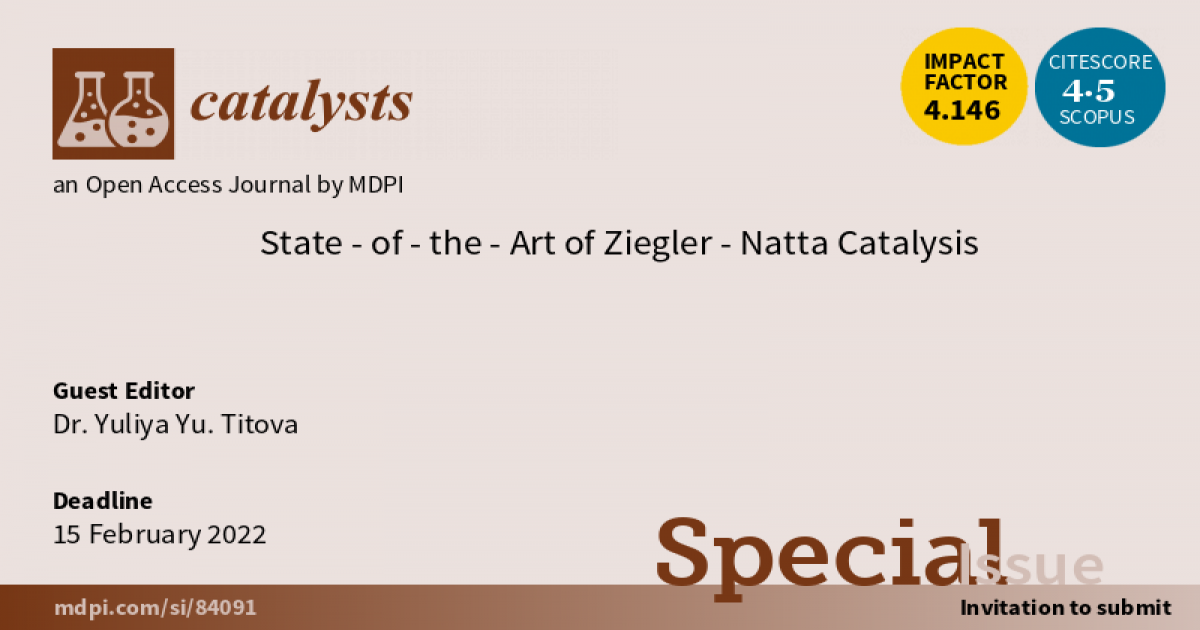- 4.0Impact Factor
- 7.6CiteScore
- 17 daysTime to First Decision
State-of-the-Art of Ziegler-Natta Catalysis
This special issue belongs to the section “Catalysis in Organic and Polymer Chemistry“.
Special Issue Information
Dear Colleagues,
The synthetic importance of the Ziegler–Natta systems go way beyond the practical needs, since these systems represent model objects for the study of relationships between structure of a catalytically active site and its quantitative characteristics (turnover frequency, turnover number, selectivity) in the processes involving activation of several types of chemical bonds. However, such studies are hindered by a great obstacle. The point is that the nature of Ziegler–Natta catalytic systems is still far from intimate understanding. First of all, this is due to their structural complexity, in which each of the components is fundamentally important for the activity and efficiency of the formed system. Therefore, chemistry of the interaction between all the main components of the systems should be intrpreted and rationalized at the molecular level. These components include transition metal complex, support (MgCl2, SiO2, etc.), cocatalyst AlRnX3-n (R – alkyl, Х – halogen), α-olefin acting as a monomer, and modifier(s) (the Lewis base also called a “donor”), as well as uncontrolled impurities inevitably entering the reaction system (for example, with water or oxygen).
This Special Issue is devoted to the most recent advances in the field of the Ziegler–Natta catalysis of α-olefin hydrogenation, oligo-/polymerization and copolymerization processes.
Dr. Yuliya Yu. Titova
Guest Editor
Manuscript Submission Information
Manuscripts should be submitted online at www.mdpi.com by registering and logging in to this website. Once you are registered, click here to go to the submission form. Manuscripts can be submitted until the deadline. All submissions that pass pre-check are peer-reviewed. Accepted papers will be published continuously in the journal (as soon as accepted) and will be listed together on the special issue website. Research articles, review articles as well as short communications are invited. For planned papers, a title and short abstract (about 250 words) can be sent to the Editorial Office for assessment.
Submitted manuscripts should not have been published previously, nor be under consideration for publication elsewhere (except conference proceedings papers). All manuscripts are thoroughly refereed through a single-blind peer-review process. A guide for authors and other relevant information for submission of manuscripts is available on the Instructions for Authors page. Catalysts is an international peer-reviewed open access monthly journal published by MDPI.
Please visit the Instructions for Authors page before submitting a manuscript. The Article Processing Charge (APC) for publication in this open access journal is 2200 CHF (Swiss Francs). Submitted papers should be well formatted and use good English. Authors may use MDPI's English editing service prior to publication or during author revisions.
Keywords
- Ziegler-Natta catalytic systems
- New aspects of formation and functioning of Ziegler-Natta systems in α-olefin hydrogenation, oligo-/polymerization and copolymerization processes
- Experimental methods and methodologies of Ziegler-Natta system investigations
- Computational methods of Ziegler-Natta systems research

Benefits of Publishing in a Special Issue
- Ease of navigation: Grouping papers by topic helps scholars navigate broad scope journals more efficiently.
- Greater discoverability: Special Issues support the reach and impact of scientific research. Articles in Special Issues are more discoverable and cited more frequently.
- Expansion of research network: Special Issues facilitate connections among authors, fostering scientific collaborations.
- External promotion: Articles in Special Issues are often promoted through the journal's social media, increasing their visibility.
- e-Book format: Special Issues with more than 10 articles can be published as dedicated e-books, ensuring wide and rapid dissemination.

